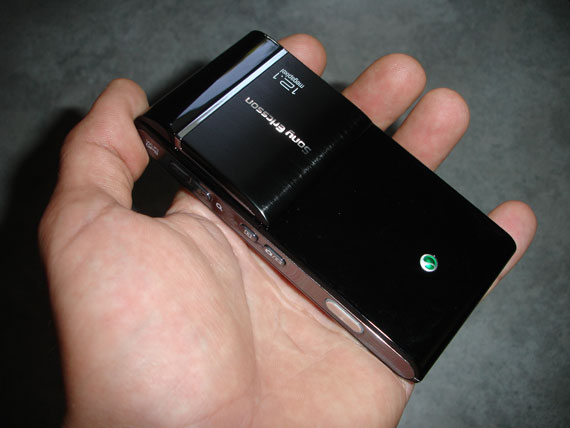Sony Ericsson Satio is a 12 mega pixel camera with xenon flash and automatic face and smile detector.
General 2G Network GSM 850 / 900 / 1800 / 1900
3G Network HSDPA 900 / 2100
HSDPA 850 / 1900 / 2100 - Satio(a) for the Americas
Announced 2009, February
Status Available. Released 2009, October
Size Dimensions 112 x 55 x 13 mm
Weight 126 g
Display Type TFT touchscreen, 16M colors
Size 360 x 640 pixels, 3.5 inches
Accelerometer sensor for UI auto-rotate
Proximity sensor for auto turn-off
Sound Alert types Vibration, MP3, AAC ringtones
Speakerphone Yes

Sound Alert types Vibration, MP3, AAC ringtones
Speakerphone Yes
Memory Phonebook Practically unlimited entries and fields, Photocall
Call records Detailed, max 30 days
Internal 128 MB storage; 256 MB RAM
Card slot microSD, up to 32GB, 8GB included, buy memory
Data GPRS Class 10 (4+1/3+2 slots), 32 - 48 kbps
EDGE Class 10, 236.8 kbps
3G HSDPA, 7.2 Mbps; HSUPA, 3.6 Mbps
WLAN Wi-Fi 802.11 b/g, DLNA
Bluetooth Yes, v2.0 with A2DP
Infrared port No
USB Yes, v2.0

Camera Primary 12 MP, 4000 x 3000 pixels, autofocus, xenon flash, video LED flash
Features Touch focus, geo-tagging, face and smile detection
Video Yes, WVGA@30fps (via software update)
Secondary VGA videocall camera
Features OS Symbian OS v9.4, Series 60 rel. 5
CPU ARM Cortex A8 600 MHz, PowerVR SGX graphics
Messaging SMS (threaded view), MMS, Email, Push Email, IM
Browser WAP 2.0/HTML, RSS reader
Radio Stereo FM radio

Features OS Symbian OS v9.4, Series 60 rel. 5
CPU ARM Cortex A8 600 MHz, PowerVR SGX graphics
Messaging SMS (threaded view), MMS, Email, Push Email, IM
Browser WAP 2.0/HTML, RSS reader
Radio Stereo FM radio
Games Yes + downloadable
Colors Black, Silver, Bordeaux
GPS Yes, with A-GPS support
Java Yes, MIDP 2.0
Google Maps
Gesture control
MP4/H.264/H.263/WMV player
MP3/WAV/WMA/eAAC+ player
TV-out
Office document viewer
Organizer
T9
Battery Standard battery, Li-Po 1000 mAh
Stand-by Up to 360 h (2G) / Up to 340 h (3G)
Talk time Up to11 h (2G) / Up to 4 h 50 min (3G)
Misc SAR EU 1.58 W/kg (head)


All mobile phone vendors hope to repeat the success of Apple with a new Jesus phone. Sony Ericsson’s candidate is Satio (previous working name Idou) and they are positioning the integrated 12 megapixel camera as the “killer app” that will lift Satio above the other smartphone competitors when it hits the shelves this fall.

In web forums such as Nikonians and review sites like DPReview most pro photographers and photo nerds have been in agreement about this for a long time. They are generally skeptical about small point-and-shoot cameras since the image noise level becomes unacceptable indoors or with low lighting. They are also critical about the way the vendors try to compensate for mediocre image quality with exaggerated electronic post-processing, by saturating the colors and by increasing edge sharpness. The result is quite often pictures that look unnatural.

a serious design mistake in their choice of camera. For marketers that are used to the IT industry’s logic that “more is always better” it is a given that cramming as many pixels as possible into the smartphone is a desirable goal. Sony Ericsson’s motivation is that the Facebook generation wants an easy way to take high quality pictures. That is correct, but a 12 MP camera phone is not the answer.
The problem is that a sensor with a lot of megapixels diminishes the ability to take good pictures in low light which, for most users, is much more important than taking high resolution pictures with 4000 x 3000 pixels. Sony Ericsson (SEMC) will run into problems when disappointed buyers realize how limited the camera is in practical usage

The number of megapixels is not the only performance factor. How tightly each pixel is packed on the sensor (Mpix/cm²) is of equal importance. If too many pixels are crammed on a sensor that is less than a square centimeter (6 × 4.5 mm if Sony’s new sensor is used in the Satio) each pixel will be so tiny that the physical limitations of the number of photons that can hit this pixel will determine the capability to produce an image.
If the camera sensor is viewed as a football field filled with buckets, the photons can be viewed as a rain of billiard balls that fall down in the buckets. Each bucket is one pixel. Stronger light produces many billiard balls which increases the precision when the number of balls in each bucket is counted.
Weak lighting conditions (few billiard balls falling down) might work if each bucket is large enough to at least catch a few balls. But if the same number of buckets is crammed into a handball field each bucket will only be the size of drinking glass and the errors (noise) will be much larger because the billiard balls are too few to fill up all the small glasses.
For pictures taken in direct sunlight in the middle of the day or with a strong flash, the lowest sensitivity (ISO 100) is sufficient. Under these lighting conditions a small sensor (the handball field) is almost on par with a large sensor (the football field). There are still differences in quality because the optics in a small sensor camera is always inferior to larger, high quality optics. Quality differences are also caused by the fact that the leading camera vendors (Nikon and Canon) have more experience with electronic image processing than new players such as SEMC.


















Wow! This is nice and a very attractive designed cell phone. It has many functionality as well. Cool! usedsprintphones
ReplyDelete